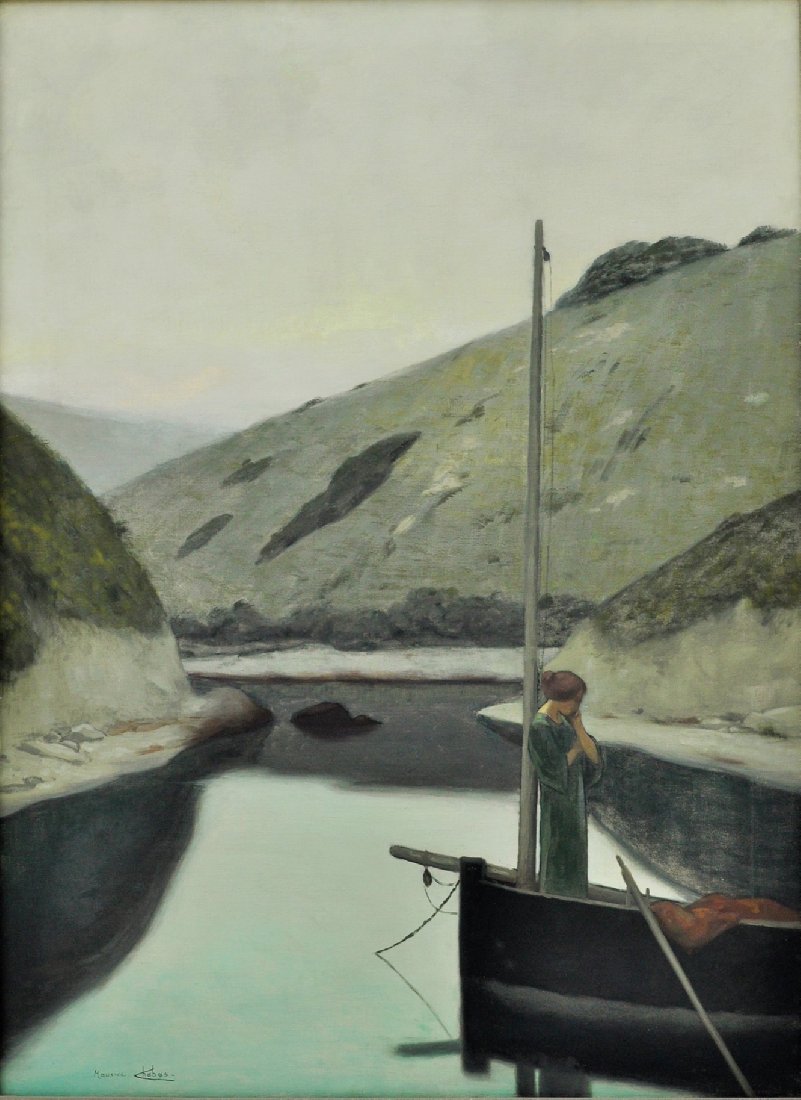Description:
“For Maurice Chabas was a poet, a great poet, who lived a life teaching the beauty of the land”[1].
Maurice Chabas (1862-1947) was a French painter, brother of Paul Chabas. He began with symbolism, then became fascinated with neo-impressionism, synthetism and abstractionism. He inherited his passion for painting from his father, Oscar. From 1883 to 1888 he attended the Julian Academy in Paris. He was a representative of the Triennale, general secretary of the Société Idéaliste, a member of the French Astronomical Society and president of the Modernist Society. In order to support cultural creators, he founded the Society of Friends of the Artist [2]. From 1892 to 1897 he exhibited at presentations of the Rose-Croix (Rosicrucians), of which he was a member and defender. He exhibited his works at the Salon des Artistes Français and the Salon de Société Nationale des Beaux-Arts. He painted wall decorations, portraits and allegorical paintings. He referred to the works of Puvis Chavannes and Maurice Denis “both in the synthetic way of treating large picture planes and in the symbolic themes”. [3]. “Art for Chabas is the spirit that accompanies his creativity in a natural way. Line, form, as well as color, express in a symbolic way the mystical connections existing between spirit and matter. For idealists, art is a memory of what is divine” [4]. Chabas is therefore looking for that ideal beauty [5]. Pure materialism means degradation of art for him. Besides what is only visible, each work should refer us to the sphere of inner life, going far beyond the image. Quoting the artist: “Every form, perceived in physical dimension, is a certain state of consciousness and we build our future form with every heartbeat, through our deepest thoughts. So since everything is vibration, the artistic or literary work cannot escape this law of life. On the contrary, it has a constant extraordinary power of suggestion … it has radiation, from which one cannot escape.”
The group “Rosicrucians”, which Maurice Chabas belonged to, owes its name to the founder – Christian Rosenkreutz, the hero of Johann Valentin Andreae’s novel, who lived in the 15th century. In Europe, associations of this type have appeared since the 17th century. They become the successors of the ancient mystery schools. They educate their followers, grant them university degrees, teach the history of the order, Hebrew language and Kabbalah. Rosicrucians presented a program of “general reform”, the repair of a world plagued by crises, striving for a harmonious and full unification of mankind through the combination of the principles of the Reformation and the philosophy of nature. According to their assumptions, the world of spirit and matter intertwine. “The Spirit of God revealed himself in Nature, therefore the study of Nature’s books, that is, scientific research, was a religious duty. The deification of nature was a characteristic feature of the writings of all Rosicrucians”. In 1890, Josephin Peladan separated from the order and created “La Rose + Croix du Templ et du Graal” (The Rose + Cross of the Temple and Grail) [4]. In 1892, the first salon de la Rose + Croix took place. This group gave special importance to the painter: “Artist, you are a priest (…) Artist, you are a king (…) Artist, you are a magician! “[5]. The works of Chabas presented at the salon fully implement the assumptions of the secret group’s teaching.
In addition to the ideological influence of the Rosicrucians, the painter’s artistic attitude is also shaped by his experience of the First World War. He actively took part in the fighting. However, the delicate psychological construct of the sensitive, young man suffers a trauma and Chabas ends up in a serious condition in the hospital in Rennes [6]. “Miraculously healed, with enthusiasm he threw himself into the whirl of work, struggling with the eternal creative process. From then on, aware of his helplessness in facing and overcoming misfortunes that ravage the world, he gained the conviction that these misfortunes were a consequence of the fact that humanity was far from ideal. Living almost like a hermit, he devoted himself almost exclusively to religious and spiritual painting” [7].
“Reflection” by Maurice Chabas is a kind of pendant to the presentation titled “Peace in Nature”. Both works are presented side by side in the first room of the Rogalin gallery.
In Chabas’s view, we see the Aven river again. This time, the hills surrounding the water’s mirror are not bathed in golden sunlight. They remain gray-green. Muted. As if blurred, because they dissolve into a milky, dreamy halo of memories. They are nostalgic. The composition of the presentation is synthetic. The mast of the boat captured on the right side of the image field remains a clear vertical accent. The woman standing in front of it supports her head with her left hand in a gesture of contemplation. The title musing prompts reflection. Both the same as the posture taken by the work, as well as reflections of a more general, existential nature. Allowing to contemplate one’s presence in the vicinity of nature and our mutual coexistence in harmony and mystical unity. In Maurice Chabas’s works, the mysticism of the simple form of representation refers us to the complex inner world of the spirit.


